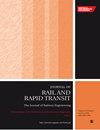A rail fastener defect detection algorithm based on improved YOLOv5
IF 1.7
4区 工程技术
Q3 ENGINEERING, CIVIL
Proceedings of the Institution of Mechanical Engineers Part F-Journal of Rail and Rapid Transit
Pub Date : 2024-02-17
DOI:10.1177/09544097241234380
引用次数: 0
Abstract
Being a crucial component of railway tracks, monitoring the health condition of fasteners stands as a critical aspect within the realm of railroad track management, ensuring the normal passage of trains. However, traditional track fastener detection methods mainly use artificial checks, giving rise to challenges encompassing reduced efficiency, safety hazards, and poor detection accuracy. Consequently, we introduce an innovative model for the detection of track fastener defects, termed YOLOv5-CGBD. In this study, we first imbue the backbone network with the CBAM attention mechanism, which elevates the network’s emphasis on pertinent feature extraction within defective regions. Subsequently, we replace the standard convolutional blocks in the neck network with the GSConv convolutional module, achieving a delicate balance between the model’s accuracy and computational speed. Augmenting our model’s capacities for efficient feature map fusion and reorganization across diverse scales, we integrate the weighted bidirectional feature pyramid network (BiFPN). Ultimately, we manipulate a lightweight decoupled head structure, which improves both detection precision and model robustness. Concurrently, to enhance the model’s performance, a data augmentation strategy is employed. The experimental findings testify to the YOLOv5-CGBD model’s ability to conduct real-time detection, with mAP0.5 scores of 0.971 and 0.747 for mAP0.5:0.95, surpassing those of the original YOLOv5 model by 2.2% and 4.1%, respectively. Furthermore, we undertake a comparative assessment, contrasting the proposed methodology with alternative approaches. The experimental outcomes manifest that the YOLOv5-CGBD model exhibits the most exceptional comprehensive detection performance while concurrently maintaining a high processing speed.基于改进型 YOLOv5 的铁路扣件缺陷检测算法
作为铁路轨道的重要组成部分,监测扣件的健康状况是铁路轨道管理的一个关键环节,可确保列车的正常通行。然而,传统的轨道扣件检测方法主要采用人工检查,存在效率低、安全隐患大、检测精度差等问题。因此,我们引入了一种创新的轨道扣件缺陷检测模型,称为 YOLOv5-CGBD。在这项研究中,我们首先为骨干网络注入了 CBAM 注意机制,从而提高了网络对缺陷区域内相关特征提取的重视程度。随后,我们用 GSConv 卷积模块取代了颈部网络中的标准卷积块,在模型的准确性和计算速度之间实现了微妙的平衡。为了增强模型在不同尺度上进行高效特征图融合和重组的能力,我们整合了加权双向特征金字塔网络(BiFPN)。最终,我们操纵了一个轻量级解耦头部结构,从而提高了检测精度和模型的鲁棒性。同时,为了提高模型的性能,我们还采用了数据增强策略。实验结果证明了 YOLOv5-CGBD 模型的实时检测能力,mAP0.5 得分为 0.971,mAP0.5:0.95 得分为 0.747,分别比原始 YOLOv5 模型高出 2.2% 和 4.1%。此外,我们还进行了比较评估,将所提出的方法与其他方法进行了对比。实验结果表明,YOLOv5-CGBD 模型在保持较高处理速度的同时,还表现出了最出色的综合检测性能。
本文章由计算机程序翻译,如有差异,请以英文原文为准。
求助全文
约1分钟内获得全文
求助全文
来源期刊

CiteScore
4.80
自引率
10.00%
发文量
91
审稿时长
7 months
期刊介绍:
The Journal of Rail and Rapid Transit is devoted to engineering in its widest interpretation applicable to rail and rapid transit. The Journal aims to promote sharing of technical knowledge, ideas and experience between engineers and researchers working in the railway field.
 求助内容:
求助内容: 应助结果提醒方式:
应助结果提醒方式:


